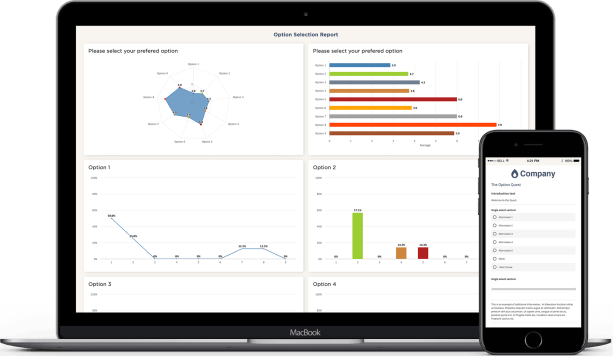Employee Surveys – a complete guide


Employee Surveys can be used for a lot of different purposes and be conducted in a variety of ways. If you want to get continuous feedback from your employees, “checking the pulse” every now and then might be the best solution for you. What questions to ask and how to ask them is an art in itself that requires you to consider a lot of factors. We will help guide you through this process.
- What is the purpose of an Employee Survey?
- What does it mean to check the pulse?
- What questions should you ask in an Employee Survey?
- Anonymity can be useful in Employee Surveys
- Following up on your Employee Survey
Try Questback 14 days for free.
What is the purpose of an Employee Survey?
In board rooms across the globe the question of whether or not employee surveys are worth the time and effort is constantly being discussed. This is, of course, something we need to answer before starting the process of conducting a survey. The first thing that you, as an organization, should do is to ask yourself what you want out of the survey. What is the purpose of the employee survey?
Why employee surveys are important for the organisation
One purpose could be to better understand how your employees feel about their workplace and their duties. Another could be to assess how well a group is working together or how your team of leaders is performing. When used correctly, employee survey results can lead to rapid positive changes both for the company and the employees. By giving your employees a platform to share their opinions, the organization can evolve and grow together with its employees.
Showing your employees that their opinions matter is a great way to create a team that is driven, engaged and loyal, all of which can have a positive effect on the overall productivity and profitability of the company. This will also have a positive effect on your customers who will mirror the employees’ happiness.
A survey by Gallup shows us that companies with high employee engagement have 10% higher customer satisfaction, 21% higher productivity and are 22% more profitable than workplaces where engagement is low.
What does it mean to check the pulse?
When checking the pulse at a workplace, you conduct a smaller, shorter survey, often multiple times a year. They most often use easy questions to allow for short, quick answers. If you’re looking for a way to get continuous feedback from your employees, checking the pulse a few times a year is the perfect tool to do so. This type of survey checks in on how the employees are doing right at the moment of the survey.
You could also use these short surveys to follow up on the development of single or multiple employees.To make sure that your best, most competent employees stay with the company, it’s important that they feel like they’re a part of the team, appreciated and have the option to develop further within the company.
The purpouse with pulse surveys
Unlike a yearly survey, these short surveys allow you to regularly check in on the overall engagement levels among your employees. This allows you to “check the pulse” and make sure your employees stay happy, over time.
Make sure to use short, direct and specific questions. An example would be to ask if the employee has the tools necessary to do their job properly or if there is something in particular they would like to see improved in the company. You could also ask if your employee would recommend a friend to apply for a job at their company.
Since these surveys are short and to the point, it’s hard to get a wide big-picture view of the working environment. For this purpose you would need to use a more comprehensive employee survey. Combining the regular, short surveys with a larger survey once or twice a year is a great strategy for both making sure everyone is happy throughout the year and to get real, extensive feedback from the bigger surveys.

Use Employee surveys to figure out what drivers you should focus on!
In this whitepaper, you will find 33 concrete tips that you can act on to immediately increase employee engagement at your workplace.
What questions should you ask in an Employee Survey?
Formulating questions that generate a lot of answers can be a tricky thing to do. The question should be easy to understand and not allow for reflection over why a particular question is asked.
Think about this when creating questions for employee surveys
Follow these simple steps to help you create a great employee survey:
- Determine the purpose of the survey
- Break the purpose down into smaller parameters
- Use these parameters to to formulate question categories
- Split up the categories in different variables to make sure the survey is as comprehensive as possible
- Read through your questions and remove ones that are too “beefy” and don’t fit into the quick survey model
- Supplement with appropriate background information
Example of employee survey questions
Uncover the essential questions to ask in an employee engagement survey in this informative video. We discuss various topics to address, such as the working environment, leadership, communication, compensation, and personal development opportunities. Learn how to measure key performance indicators (KPIs) like engagement, satisfaction, and loyalty towards the employer, and gain insights on how to effectively design employee surveys to yield valuable feedback. Elevate your organization’s understanding of employee needs and drive improvements with these critical survey questions!
You should also remember to ask questions that are relevant and to the point. Having questions that are too leading will affect the respondents too much. Try to formulate your questions in a neutral way. Put the most important questions at the beginning of the survey, to take advantage of the higher engagement that respondents have when starting a survey. You could create a mix of short and a little longer questions and try to keep the survey at 10 or fewer questions. Make sure to let the respondents know that their answers are anonymous to allow them to speak freely and be honest.
Anonymity can be useful in Employee Surveys
Keeping the replies anonymous could help you get honest answers from your employees, although this is a theory that’s very open to discussion. Quite a few survey results do however show that most employees are too afraid to be too critical in a survey unless they’re replies are anonymous.
And you need the honest opinions of your employees, the good and the bad, to know what you need to improve and work on. This is the first step to grow as an organization. This makes it very important that the employees feel like they can be honest in a survey without it leading to negative consequences.
How to secure anonymity at employee surveys
In Questback Essentials there are tools in place that allow for anonymous participation in surveys. If you activate these tools, the respondents information is not stored anywhere and you can’t identify the person behind the answers. What browser they used, IP-addresses, OS and e-mail addresses are never stored when you make a Quest anonymous. Use this option to keep the respondents identity hidden. You can learn how to create a Quest where the respondents’ identities are hidden here.
Does the employee survey need to be anonymous?
Following up on your Employee Survey
Once the survey has been completed and you’ve collected all of the replies, it is time to do some follow-up work. Following up on the survey is all about acting on the feedback you received. This is the absolute biggest part of the survey when it comes to creating change.
You should now create plans of action based on what changes you want to accomplish. You can focus on what to prioritize, set up time-frames, instructions and also set a date for when the next survey should be. Taking the stats and replies from your survey and turning them into actual change can be done in a number of ways. An effective way to do this is to involve the employees in the plans of action.
Follow up and handling the result from employee surveys
Sometimes an employee might decline to participate in a survey. The reason for this could be that they don’t actually believe that any change will come out of it. This is why it’s extremely important that you communicate what the purpose of the survey is and what the plan is after it’s done. You should also make sure everyone knows what changes are being made, based on the survey results. If the company cannot accomplish certain things touched on in the survey, this should also be communicated to the employees.
If you start with the easy parts of your plans, that should make it easier to get the process going and help motivate everyone to make bigger changes. This also shows the employees that the management are actually listening to them and taking their feedback seriously.
Tracking Success: Key KPIs for Employee Engagement and Satisfaction
Dive into the world of key performance indicators (KPIs) for employee engagement and satisfaction in this eye-opening video.
FAQ
1. Sign up for a feedback platform or an equivalent tool.
2. Formulate questions that are relevant to your employees from several aspects like general satisfaction, executives etc.
3. Send the survey to relevant employees.
4. Analyse the answers and segment the data based department for example.
5. Take actions for increased employee satisfaction, leading to higher employee retention rate and profitability.
Employee surveys are effective to gain insights about how people are feeling about the workplace in general or about other specific topics and the organisation can thereafter work for lower employee churn and higher profitability based on data.
Many employers would like to gain control over how commitment and loyalty develop among employees during their journey with them. There are different types of surveys that can support them to get the insights needed. Important in this work is that organizations both have the right system that helps them get the feedback in and choose the right structure and planning so that they succeed in asking the right questions at the right time.
By having a satisfied and committed staff, you can increase productivity, reduce staff turnover and create a positive work environment.
Employee engagement and satisfaction are important prerequisites for the organization if they are to succeed in reaching their goals and develop in the right direction. If there are larger groups of employees or key persons, managers who are not on board, the organization will stagnate and not succeed as well in development.
A question we often get from our customers and the answer lies more in the organizations' ability to act on the results, anchor them internally both among managers and employees and implement measures and improvements
When carrying out an employee survey, you can ask questions relating to work environment, leadership, communication, skills development, compensation as well as commitment and satisfaction.
It's about employee engagement, referral propensity, loyalty. These key figures can then be set against other HR data such as sickness absence figures, staff turnover, productivity
Organisations should see it as a way to improve and push through innovations and developments with the help of employee input and feedback. By showing that you take employee feedback seriously, you can also increase their motivation and commitment in the workplace.

Try Questback
Questback is a leading Customer and Employee Experience solution that makes it easy to collect, analyse and take action on key stakeholder insights.









